-
Technical Notes
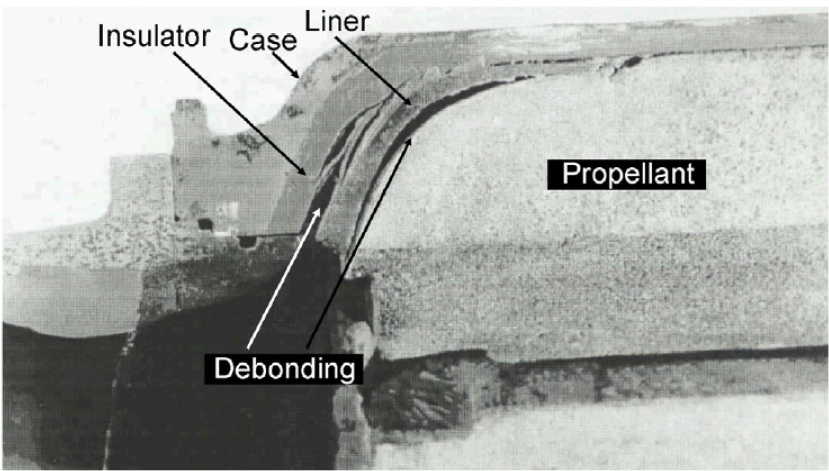
-
Research Trends in Combustion and Structural Health Monitoring Technologies for Solid Propulsion Systems
고체추진기관 연소/구조 건전성 모니터링 기술의 연구 동향
-
Eunji Yi, Seongpil Joo
이은지, 주성필
- Solid propulsion systems are widely used in aerospace and defense due to their high energy density and storability. However, irreversible combustion and …
- Solid propulsion systems are widely used in aerospace and defense due to their high energy density and storability. However, irreversible combustion and long-term exposure to harsh environments require accurate assessment of material degradation. Conventional health monitoring relies on destructive testing, which is time-consuming and costly. Recently, sensor-based structural health monitoring(SHM) and digital twin technologies have gained attention as alternatives, though their application to solid propulsion remains limited due to nonlinear degradation and sensor integration challenges. This paper reviews degradation mechanisms in solid motors and explores SHM and digital twin strategies applied in other propulsion systems. A framework combining embedded sensors, multiphysics simulation, and AI-driven prediction is proposed to enable real-time diagnostics and condition-based maintenance for solid propulsion systems. - COLLAPSE
-
Research Trends in Combustion and Structural Health Monitoring Technologies for Solid Propulsion Systems
-
Research Article
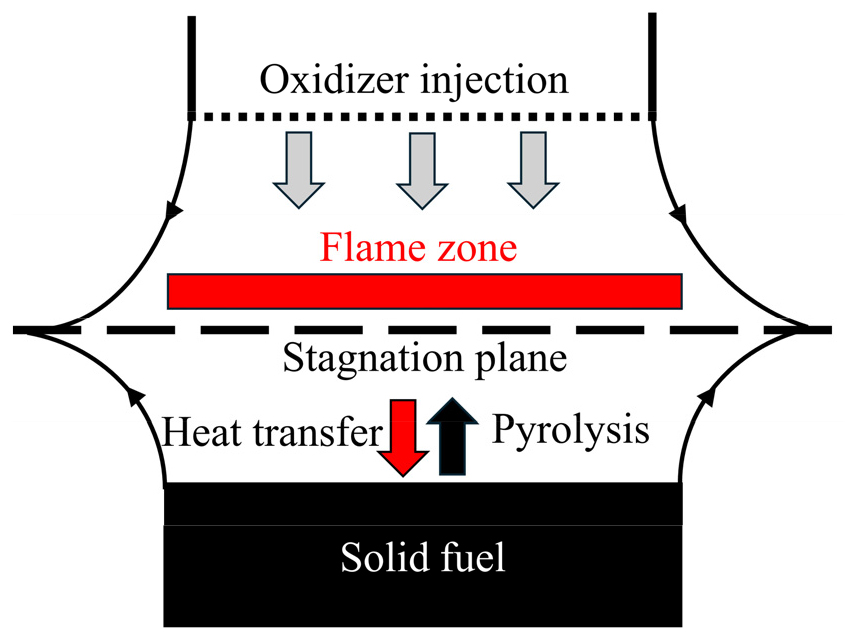
-
Numerical Investigation of Regression Rate and Combustion Characteristics of Solid Fuel Using Counterflow Combustion Simulations
대향류 연소 해석을 통한 고체연료의 후퇴율 및 연소 특성 예측에 관한 연구
-
Eunchong Kim, Lin Yun, Hyung Sub Sim
김은총, 윤린, 심형섭
- This study investigates the regression rate and combustion characteristics of solid fuel using a simple one-dimensional counterflow diffusion flame analysis. A coupled …
- This study investigates the regression rate and combustion characteristics of solid fuel using a simple one-dimensional counterflow diffusion flame analysis. A coupled computational framework was developed by integrating gas-phase and condensed-phase reaction models. Simulation results were validated using regression rates from counterflow combustion experiments. Furthermore, the effects of oxygen concentration, ambient pressure, and oxidizer momentum flux on the combustion behaviors of solid fuel were systematically examined. The predicted regression rates showed good agreement with experimental data across the range of conditions tested in this study, although discrepancies were observed at lower pressures. An increase in oxygen concentration, ambient pressure, and oxidizer momentum flux was found to enhance the regression rate. In particular, the increase in momentum flux and pressure shifts the peak temperature location closer to the fuel surface. This proximity intensifies heat feedback to the solid surface, thereby accelerating the pyrolysis process and increasing the regression rate. Furthermore, the correlation analysis identified the oxygen mass fraction as the most influential of the three examined parameters affecting the regression rate. These findings offer fundamental insight into the pyrolysis and combustion of solid fuel relevant to air-breathing solid fuel propulsion systems. - COLLAPSE
-
Numerical Investigation of Regression Rate and Combustion Characteristics of Solid Fuel Using Counterflow Combustion Simulations
-
Research Article

-
Research on the Development of an Oxy-Fuel Burner Utilizing Low-Calorific Byproduct Gas
저발열량 부생가스 활용 순산소 버너 개발 연구
-
Taeyoung Kim, Hyungjun Ahn, Jin Gyu Kwon, Kibeom Yang, Kyungmin Min
김태영, 안형준, 권진규, 양기범, 민경민
- This study aims to establish design parameters for an oxy-fuel burner to efficiently combust LDG, a low-calorific fuel from steelmaking processes. Using …
- This study aims to establish design parameters for an oxy-fuel burner to efficiently combust LDG, a low-calorific fuel from steelmaking processes. Using a 100,000 kcal/h experimental burner, combustion characteristics were analyzed with design parameters including Re, J and S/D number. The results indicated that the momentum flux of the oxygen jet significantly impacts combustion. Variations in the S/D number affected the flow of fuel and external air. CO emissions increased when the SF/DA number exceeded 1.5 due to insufficient fuel entrainment. To reduce NO emissions, minimizing external air entrainment by adjusting the number of oxygen nozzles and maximizing the S/D number was effective. This research provides essential design parameters for stable and efficient combustion of low-calorific fuels such as LDG. - COLLAPSE
-
Research on the Development of an Oxy-Fuel Burner Utilizing Low-Calorific Byproduct Gas
-
Research Article
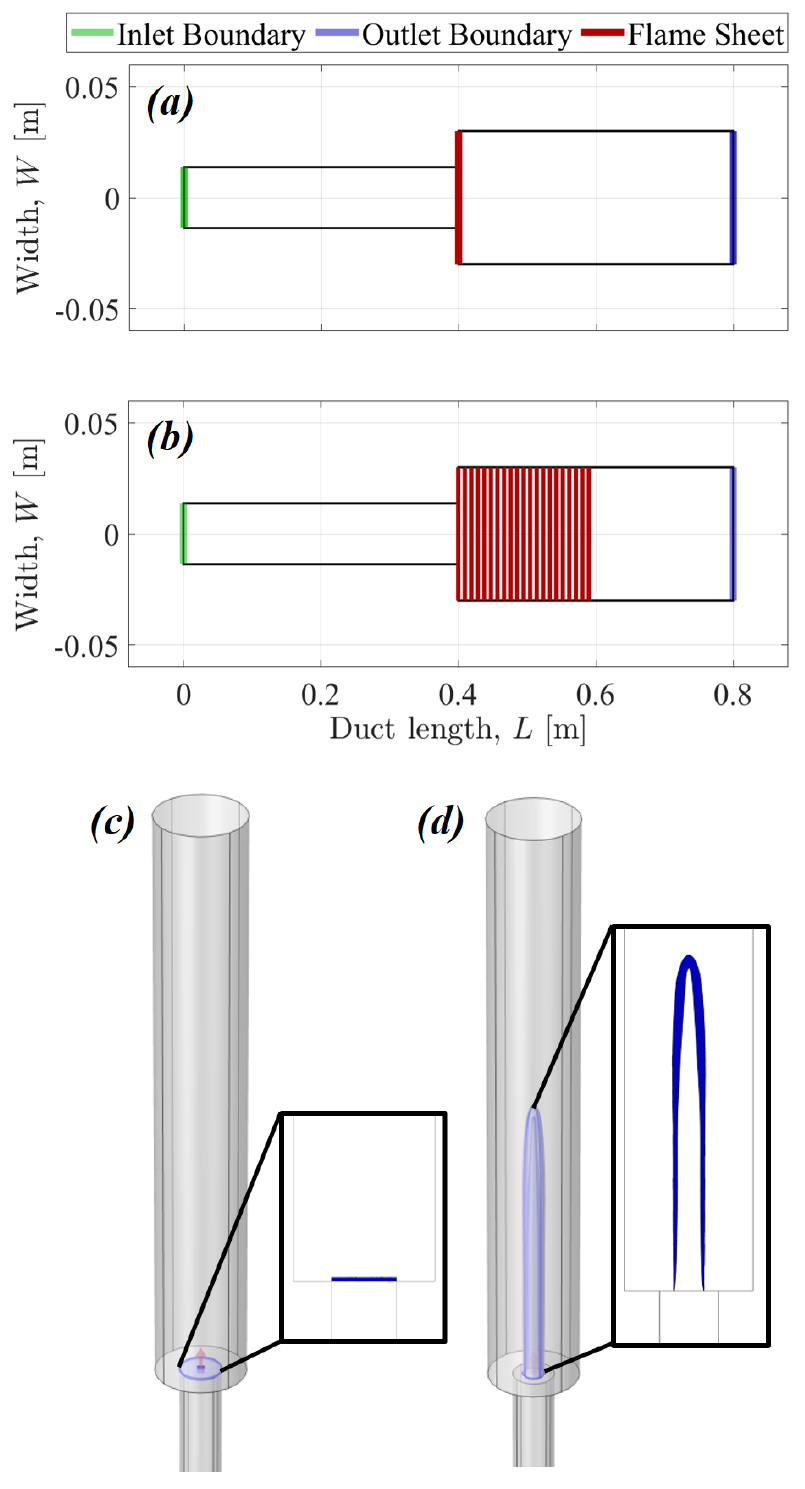
-
Numerical Study of Flame Length Effects on Low-Order Thermoacoustic Models
화염 길이가 저차원 열음향 모델에 미치는 영향에 대한 수치적 연구
-
Juwon Kim, Seungmin Guk, Minwoo Lee
김주원, 국승민, 이민우
- The thermoacoustic network model is a low-order modeling approach used to analyze and predict thermoacoustic instabilities arising from the positive interaction between …
- The thermoacoustic network model is a low-order modeling approach used to analyze and predict thermoacoustic instabilities arising from the positive interaction between unsteady heat release and a combustor’s acoustic field. In this study, we question the conventional assumption of a compact flame in thermoacoustic network models by systematically analyzing the effect of flame length on this low-order framework. We first compare the growth rates and mode frequencies of thin and long flames using a three-dimensional analysis tool, revealing a clear discrepancy between the two cases. We then evaluate a one-dimensional network modeling strategy that segments the flame. The results indicate that both the thin-flame assumption and the segmented-flame approach fail to reproduce the full thermoacoustic dynamics within the combustor. We also investigate the influence of varying gain and time delay parameters on growth rates and mode frequencies. The findings of this study demonstrate that flame length has a significant impact on thermoacoustic behavior, and this influence should be appropriately incorporated into low-order thermoacoustic models. Based on these observations, we suggest future research directions for improving existing thermoacoustic network models. - COLLAPSE
-
Numerical Study of Flame Length Effects on Low-Order Thermoacoustic Models
-
Research Article
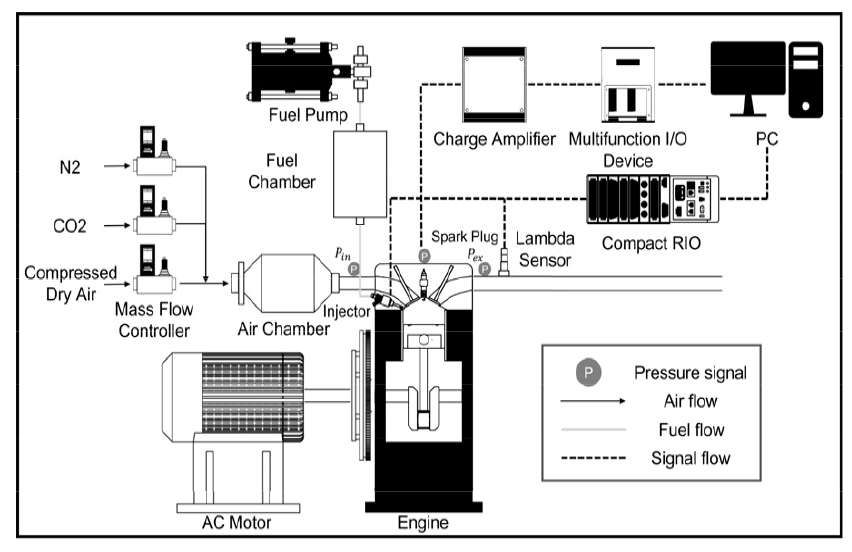
-
Effects of Multi-stage Ignition Strategies on Combustion Characteristics in a Direct Injection Spark Ignition Engine under Simulated EGR Conditions
모사 EGR 환경에서 다단점화 전략이 직접 분사식 불꽃 점화 엔진의 연소 성능에 미치는 영향
-
Kanghyun Lee, Hoseung Yi, Youngseok Song, Sungwook Park
이강현, 이호승, 송영석, 박성욱
- This study compared the combustion characteristics of a commercial ignition coil and two multi-stage ignition coils in a single-cylinder DISI engine. The …
- This study compared the combustion characteristics of a commercial ignition coil and two multi-stage ignition coils in a single-cylinder DISI engine. The multi-stage ignition coils each comprise two coils and operate in simultaneous (S-mode) and continuous (C-mode) modes; simulated EGR was applied to create a combustion-unstable environment. At 30% EGR, the S-mode showed lower combustion pressure, longer combustion duration, and reduced combustion stability than the commercial ignition coil, resulting in higher indicated specific fuel consumption. The C-mode exhibited performance comparable to the commercial ignition coil at 30% EGR. At 35% EGR, the C-mode maintained higher combustion pressure and shorter ignition delay, yielding lower IMEP COV and an ISFC reduction exceeding 10% relative the commercial ignition coil. - COLLAPSE
-
Effects of Multi-stage Ignition Strategies on Combustion Characteristics in a Direct Injection Spark Ignition Engine under Simulated EGR Conditions
-
Research Article
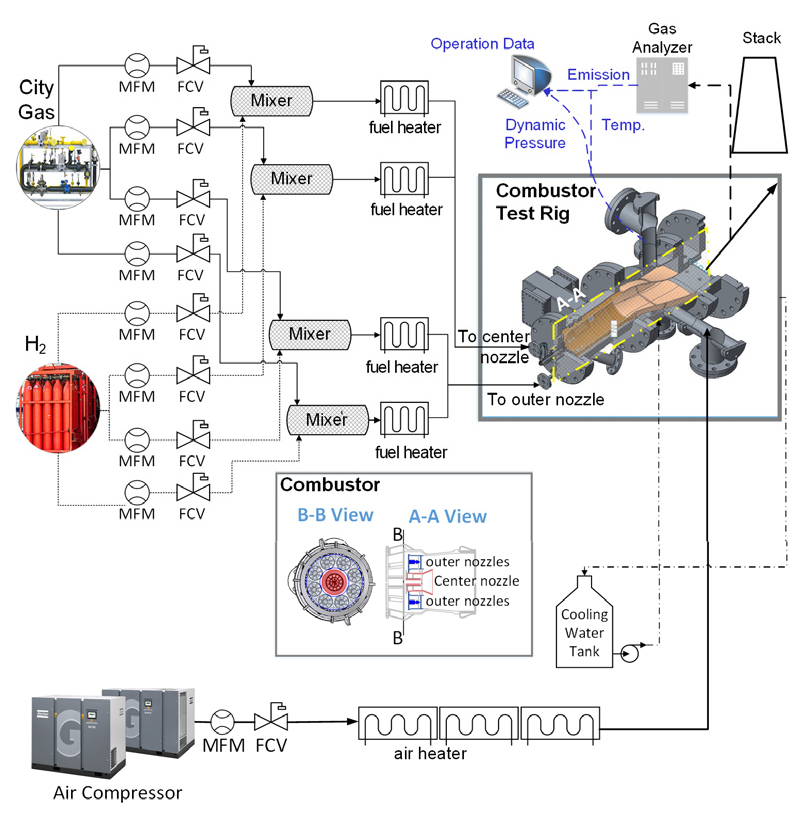
-
Experimental Study of the Hydrogen Co-Firing Characteristics on the Gas Turbine Combustor and Operational Stability Assessment
운영중 가스터빈 대상 수소혼소 특성 및 운영 안정성 시험 평가
-
Jungkeuk Park, Inwoo Hwang, Sobin Oh, Hyuckjun Jang, Karam Han, Nakjeong Choi, Yunjin Kim
박정극, 황인우, 오소빈, 장혁준, 한가람, 최낙정, 김윤진
- Hydrogen is a key fuel for reducing greenhouse gas emissions in the gas turbine sector, but its combustion characteristics differ from natural …
- Hydrogen is a key fuel for reducing greenhouse gas emissions in the gas turbine sector, but its combustion characteristics differ from natural gas and may impair combustor stability. Power producers are considering its applicability, although assessing co-firing limits remains largely within OEMs. In this study, hydrogen co-firing tests were conducted under atmospheric conditions to evaluate combustion characteristics and stable operating limits. As the hydrogen ratio increased, nitrogen oxide concentrations rose while carbon monoxide decreased, and combustion dynamics exhibited pronounced low-frequency variations. The surface temperature of combustor hot-section components also showed location-dependent behavior. - COLLAPSE
-
Experimental Study of the Hydrogen Co-Firing Characteristics on the Gas Turbine Combustor and Operational Stability Assessment
Journal Informaiton
 Journal of the Korean Society of Combustion
Journal of the Korean Society of Combustion
Journal Informaiton
Journal Informaiton - close
 Journal of the Korean Society of Combustion
Journal of the Korean Society of Combustion











